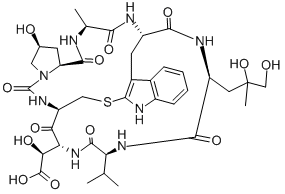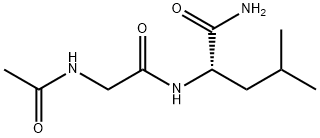PHALLACIDIN
Synonym(s):Cyclo(Ala-2-Mercapto-Trp-4,5-Dihydroxy-Leu-Val-erythro-3-Hydroxy-D -Asp-Cys-cis-4-Hydroxy-Pro)
- CAS NO.:26645-35-2
- Empirical Formula: C37H50N8O13S
- Molecular Weight: 846.9
- MDL number: MFCD00063359
- SAFETY DATA SHEET (SDS)
- Update Date: 2025-08-20 16:56:20

What is PHALLACIDIN?
Description
Phallacidin is a natural mycotoxin first isolated from the death cap mushroom, A. phalloides. It binds filamentous actin (F-actin) like phalloidin , but contains a carboxyl group for coupling reactions.
The Uses of PHALLACIDIN
Toxin Phallacidin is a weak fluorescent bicyclic peptide probe in aquous solution, Which is isolated from Amanita phalloides mushroom and could be used for blocking F-actin staining by labeled phallotoxins, which promotes actin polymerization.
The Uses of PHALLACIDIN
Phallacidin is a natural mycotoxin first isolated from the death cap mushroom. It binds filamentous actin like phalloidin.
What are the applications of Application
Phallacidin is an F-actin stabilizing toxin useful for conjugation to fluorescent molecules to actin filaments
Definition
ChEBI: A homodetic bicyclic heptapeptide having a sulfide bridge.
Biochem/physiol Actions
Phallacidin, which is a bicyclic toxin from the Amanita phalloides mushroom, has been shown to inhibit F-actin degradation by proteolytic enzymes including trypsin and α-chymotrypsin.
Enzyme inhibitor
This cyclic heptapeptide toxin (FWfree-acid = 846.92 g/mol; CAS 26645-35-2) from the poisonous green fungus Amanita phalloides stabilizes actin filaments and inhibits actin filament depolymerization. NBD phallacidin is a high-affinity, filamentous actin probe consisting of rabbit actin that is conjugated by reacting its thiol group with 4-chloro-7- nitrobenzofurazan, a yellow-green fluorescent dye. NBD phallacidin (Excitation at 465 nm; Emission at 536 nm) selectively stains F-actin un a manner that is superior to antibody staining, preferably in fixed and permeabilized samples. See Phalloidin
Properties of PHALLACIDIN
| Density | 1.1678 (rough estimate) |
| refractive index | 1.7400 (estimate) |
| solubility | DMF: Soluble; DMSO: Soluble; Methanol: Soluble; Water: Soluble |
| form | White to off-white powder. |
| color | White to off-white |
Safety information for PHALLACIDIN
| Signal word | Danger |
| Pictogram(s) |
 Skull and Crossbones Acute Toxicity GHS06 |
| Precautionary Statement Codes |
P260:Do not breathe dust/fume/gas/mist/vapours/spray. P262:Do not get in eyes, on skin, or on clothing. P264:Wash hands thoroughly after handling. P264:Wash skin thouroughly after handling. P280:Wear protective gloves/protective clothing/eye protection/face protection. |
Computed Descriptors for PHALLACIDIN
New Products
4,4-Difluoropiperidine hydrochloride tert-butyl 9-methoxy-3-azaspiro[5.5]undecane-3-carboxylate Indole Methyl Resin N-Isopropylurea N,N-Dicyclohexylcarbodiimide(DCC) MELDRUMS ACID 5-METHYLISOXAZOLE-4-CARBOXYLIC ACID Magnessium Bis glycinate Zinc ascorbate 1-bromo-2-butyne 2-acetamidophenol 9(10H)-anthracenone Erythrosin B, 4-Piperidinopiperidine 2-((4-morpholinophenylamino) (methylthio) methylene) malononitrile 2,4-dihydroxybenzaldehyde 3-(4-morpholinophenylamino)-5-amino-1H-pyrazole-4-carbonitrile Methyl 2-methylquinoline-6-carboxylate 2,6-dichloro-4-nitropyridine 4-Bromo-2-chlorobenzonitrile 2-(benzylamino)acetic acid hydrochloride 4-(tert-Butoxycarbonylamino)but- 2-ynoic acid 3,4-dihydro-2H-benzo[b][1,4]dioxepine 1-Phenyl-1-cycloprppanecarboxylicacidRelated products of tetrahydrofuran








You may like
-
 Phallacidin from Amanita phalloides CAS 26645-35-2View Details
Phallacidin from Amanita phalloides CAS 26645-35-2View Details
26645-35-2 -
 3-(4-amino-1-oxoisoindolin-2-yl)-1-methylpiperidine-2,6-dione 98%View Details
3-(4-amino-1-oxoisoindolin-2-yl)-1-methylpiperidine-2,6-dione 98%View Details -
 614-19-7 98%View Details
614-19-7 98%View Details
614-19-7 -
 3112-85-4 Methyl phenyl sulfone 98%View Details
3112-85-4 Methyl phenyl sulfone 98%View Details
3112-85-4 -
 20677-73-0 (2,2-diethoxyethyl)methylamine 98%View Details
20677-73-0 (2,2-diethoxyethyl)methylamine 98%View Details
20677-73-0 -
 3-(4-(hydroxyamino)-1-oxoisoindolin-2-yl)piperidine-2,6-dione 98%View Details
3-(4-(hydroxyamino)-1-oxoisoindolin-2-yl)piperidine-2,6-dione 98%View Details -
 57381-49-4 2-bromo-4-chlorobenzonitrile 98%View Details
57381-49-4 2-bromo-4-chlorobenzonitrile 98%View Details
57381-49-4 -
 4,6-dichloropyrimidine-5-carbaldehyde 98%View Details
4,6-dichloropyrimidine-5-carbaldehyde 98%View Details
5305-40-8
